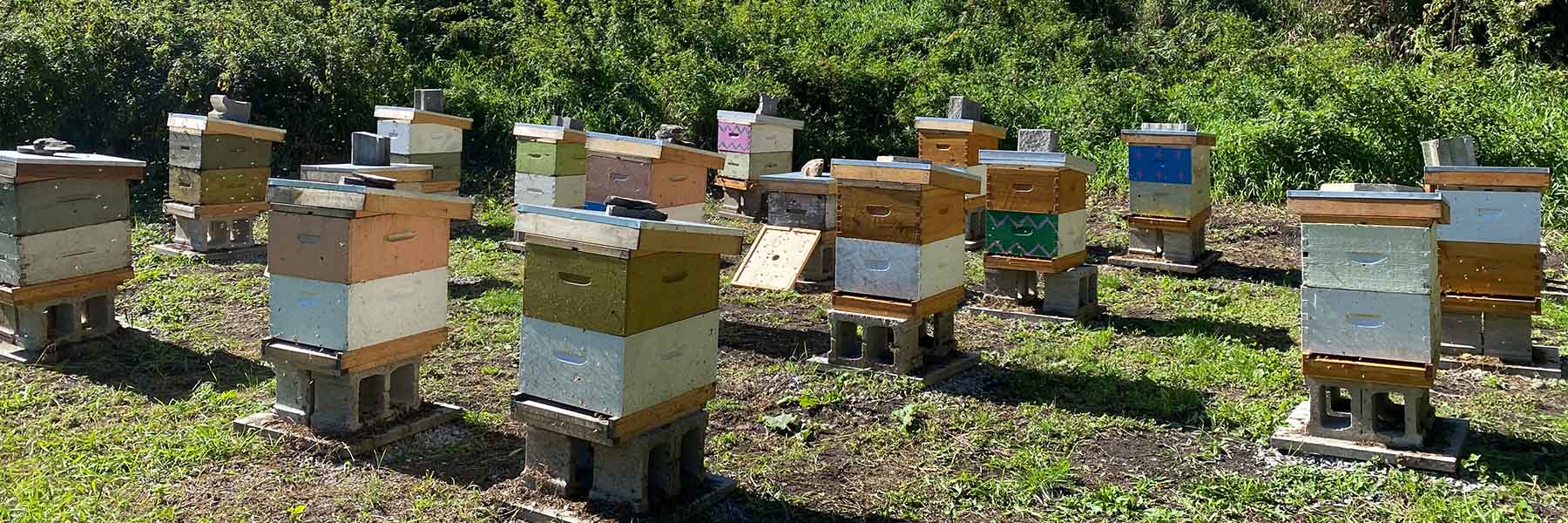You likely have a jar or two of honey at home right now. Beyond knowing that it’s a delicious superfood and a great substitute for sugar, you probably know that it’s made by bees who harvest their raw ingredients from flowers. But, if you had to explain the process in detail, or even what exactly bees use to make it, you might have more trouble. Luckily, you don’t have to. Here’s everything you need to know about honey — from how it’s made to how to use it.
What is honey?
It’s hard to miss the yellow pollen sacks on a bee’s legs as it flits from flower to flower. Watching these industrious insects visiting the local flora, it’s not a stretch to think that they’re on a quest solely for pollen. And, during the warmer months when flowers are in bloom and pollen is plentiful, bees do eat a tonne of it. Pollen is a nutritional powerhouse after all, containing proteins, fatty acids, a ton of vitamins, and more.
But bees are also after something else inside the flowers they frequent — nectar. Nectar is a deliciously sweet fluid, and provides a much needed source of energy, or carbohydrates for the bees. Worker bees sip as much of it as they can on their foraging trips. They also arrange to bring it back to the hive where it’s turned into that highly-prized, golden liquid — honey.
Do other species make honey?
The honey in your house likely came from a Western honey bee, also known as Apis mellifera. Although there are up to a dozen species of honey bees worldwide, Apis mellifera is the most common, and produces the lion’s share of globally-consumed honey.
Beyond various species of honey bees, honey is also made by the Mexican honey wasp. While it’s considered a delicacy, Mexican honey wasp honey can sometimes prove toxic if made with the nectar from certain flowers.
Outside of this, aphids and some other insects produce honeydew, a sweet substance from the sap of various plants. In some parts of the world, colonies of bees feed on this honeydew as a base for making honey. This is known as honeydew honey or forest honey and is typically darker and less sweet than “regular” honey.
How is honey made?

To begin their process, honey bees must first find nectar-producing flowers. They prefer to do this close to their hive, but can travel up to 12 km to find food. Once a bee finds a suitable flower, they use their proboscis — sort of like a mini version of an elephant’s trunk — to reach into the flower and draw out the nectar.
From there, the bee secretes the sweet liquid into their nectar sac — an internal sac connected to, but separate from, their stomach. Once finished, they repeat the process again, visiting between 50-100 flowers each trip. Depending on the weather, temperature, and amount of available nectar, each bee undertakes between five to 15 trips a day.

Once the bee returns to the hive, it regurgitates the nectar it has collected onto its tongue, or glossa, where it’s harvested by another bee. This process occurs several times, transferring the liquid from bee to bee. Finally, the nascent honey is deposited into one of the honeycombs — a hexagonal cell made of beeswax.
The process doesn’t end there, however. Nectar has a much higher water content than honey — about 70% compared to 17%. In order to remove this excess liquid, the bees fan their wings over the cells of honey, creating a breeze. This circulates air through the hive, helping to evaporate the moisture. Once the honey reaches the ideal concentration, the bees seal it in with a covering of beeswax.
How does honey go from the hive to the jar?
Bees depend on honey to feed them throughout the winter. To ensure the colony makes it safely through the colder months, producers can either supplement their diet with a sugar syrup or leave them with some of their own stores. In a colder Canadian climate, this can mean anywhere from 90-100 pounds of honey.
Once the beekeeper decides on the number of frames to remove, they’ll bring them inside to uncap the honey. First though, they have to coax the bees off of them. Because each honey cell is capped with wax, the keeper can gently shake the honeycomb without disturbing the liquid inside. Alternatively, they can smoke the frames to remove the bees as they take them out of the hive. Neither method bothers the insects, who will continue doing what they were already doing.
From there, the beekeeper has to detach the beeswax caps on the cells. They can do this relatively easily with a couple of specialized tools — either an uncapping comb, or an uncapping knife. These tools essentially scrape off the sheets of wax covering the individual cells of honey.
Removing the wax exposes the honey below. But, it’s not a matter of simply turning the frames upside down and watching the liquid pour out. Drawing the honey out is a job for the extractor — a large drum-shaped machine with individual slots for frames. Similar to a washing machine, the extractor spins quickly, using centrifugal force to coax the liquid out of the comb.
As the force of the spinning removes the honey, it pools at the bottom of the extractor, which is equipped with a nozzle. After the frames empty, the keeper opens the nozzle to let the honey flow out.
At this stage the beekeeper can strain the golden liquid as much or as little as they want. It can also be creamed, aged, pasteurized, or kept raw, depending on their production choices.

Is honey good for you?
Beyond being a delicious spread and a great addition to recipes, honey has both antioxidant and anti-inflammatory properties, which confer a number of health benefits. Studies show that honey may have a positive effect on everything from your liver to your cardiovascular health. And, despite being a sweetener, it may even hold promise for diabetes management.
What are the different varieties of honey?
Not all honey is created equal. Everything from production methods to what the bees use to make that wonderfully sweet golden liquid matters. Here’s a primer on honey and its variations.
What is creamed honey?
If you’ve ever had old honey that’s begun to crystalize, you know it can be hard to scoop out of the jar, let alone spread on anything. Creaming honey aims to avoid this issue entirely by changing the structure of the honey.
Producers do this by adding tiny crystals from honey that has already crystalized to a new batch and stirring the mixture repeatedly. The end result is a smooth, creamy, and lighter-coloured product, known as whipped, churned, or creamed honey.
Creamed honey can also be infused, for an added pop of flavour. Popular choices include raspberry, cinnamon, and matcha-infused creamed honey.
Manuka honey
Manuka is made from the nectar of the flowering plant Leptospermum scoparium, known as the manuka tree in New Zealand and tea tree in Australia. Manuka honey has a high concentration of methylglyoxal, up to 100 times higher than traditional multi-flower honey. This increases its antibacterial, antiviral, and anti-inflammatory properties making it highly sought after.
What is raw honey?
Raw honey is honey in its unprocessed form — the golden liquid closest to what the bees consume. Taken directly from the hive and decanted, raw honey doesn’t undergo pasteurization which leaves its health benefits intact. Raw honey contains varying degrees of pollen and beeswax as well as particles of propolis and royal jelly. This makes it both more desirable and cloudier than processed forms, though it can be strained to make it more translucent.
What is aged honey?
Some believe that honey, much like wine, gets better with age. As it matures, the honey darkens and its flavour changes. Certain producers even enclose their aged honey in old whiskey barrels, imparting a distinctive flavour to the finished product.
Can honey have different flavours and colours?
Yes! Honey is extremely variable. Most honeys are multi-flower varieties, made from the nectar of a number of different kinds of flowers. As a result, their flavours and colours can vary considerably depending on the combination of flowers the bees visit.
This is why honey ranges in colour from light and transparent, all the way through dark amber and beyond. Even over one season hives can produce batches varying in colour and flavour as different flowers begin to bloom.
Single varietal honeys, made with the nectar from one specific type of flower also exist. Manuka honey, for example, is a single varietal. Other favourite single varietal honeys include lavender, heather, and orange blossom, each with a distinct aroma, flavour, and colour.
How do I know when honey is bad?
You’ve probably heard a story or two about ancient honey discovered hundreds of years after it was originally stored, as fresh and safe to eat as the day it came out of the hive. And it’s true that honey’s natural antimicrobial and antibacterial properties can keep it fresh for years. It doesn't mean, however, that honey can’t go bad.
Like all foods, honey is subject to contamination. Introducing any kind of foreign material into your honey, whether it’s a piece of food or even saliva, provides a medium for bacteria to grow. If you do this and notice mould growing in your honey jar — even a tiny amount — it’s time to throw it out.
Not only that, but if you add moisture to your honey or heat it, you’re likely to spur fermentation. You can tell if that’s happened if your honey has a layer of water, contains foam, or smells like alcohol. If your honey develops any of those characteristics, it’s tossing time.
While it might seem like crystallization or darkening is an indication that your honey is past its best-before date, it hasn’t. Both are part of the natural aging process, and despite the change in colour and consistency, your honey is just as edible as before. Some people even prefer theirs this way which is why aged honey is a thing.
Outside of its health benefits, honey is just plain delicious. So the next time you’re looking to wind down for a good night’s sleep or raise your recipe game, consider adding a touch of honey. And when you do, stop to consider those fuzzy, industrious bees that pack all that goodness into every drop of sweetness.




